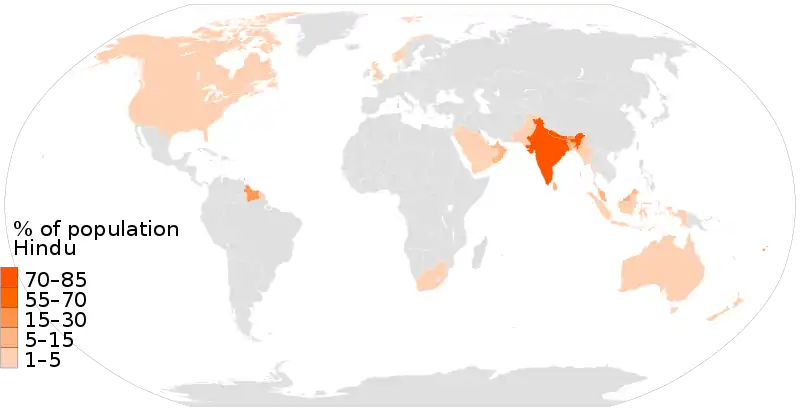Hinduism in Armenia
Hinduism in Armenia remains a minor feature in Armenian religious life, generally represented through The International Society for Krishna Consciousness and a minority of Indian students, with backgrounds in Hinduism.
| Hinduism by country |
|---|
  |
| Full list |
History
There was a colony of Indians on the upper Euphrates in Armenia as early as second century BC and temples were raised in honour of Sri Krishna, a representation of the Supreme Personality of Godhead in Gaudiya Vaishnavism.[1][2]
According to Zenob Glak, one of the first disciples of Gregory the Illuminator, the patron saint of Armenia, at least 7 Hindu cities were established in Armenia sometime around 349 B.C. The institution of Nakharar was founded by Hindu Kings from even earlier. Zenob wrote that the colony was established by two Indian princes from Ujjain who had taken refuge in Armenia.[3] They worshipped Ganesha and their descendants multiplied and ruled over a large part of Armenia. Under the rulers, the Hindu cities flourished until the dawn of Christianity in Armenia in 301 A.D.[4]
The ruins of the Saint Karapet Monastery, now in Turkey, stands at the site of the Hindu temples.[5][6]
Religious organisations
The International Society for Krishna Consciousness (ISKCON) and Transcendental Meditation organisations are both active in Armenia.[7] In 1990 ISKCON was, for the first time, officially registered as a religion in Armenia. There are now about 250 ISKCON members resident in Armenia and ISKCON maintains congregations in the towns of Gyumri, Vanadzor, Yeghegnadzor, Kapan and Ashtarak.
See also
References
- Priyatosh Banerjee (1992). New Light on Central Asian Art and Iconography. Abha Prakashan. p. 82. ISBN 9788185704210.
- Kennedy, J (April 1904). "The Indians in Armenia. 130 B.C.-300 A.D." Journal of the Royal Asiatic Society of Great Britain and Ireland. Cambridge University Press. 36 (2): 309–314. doi:10.1017/S0035869X00031749. JSTOR 25208635. S2CID 162742520. Retrieved 30 September 2022.
- India-Eurasia, the way ahead: with special focus on Caucasus, Centre for Research in Rural and Industrial Development, Centre for Caucasian Study Centre for Research in Rural and Industrial Development, 2008 p. 205
- Memoir of a Hindu Colony in Ancient Armenia, by Johannes Avdall, Esq., M. A. S., Journal of the Asiatic Society of Bengal, Volume V, Issue 54, 1836, II.
- Ghrejyan, Lousine (2010). "Երկվորյակների առասպելի ելակետային արժեքը հայ վիպական հուշարձանների հորինվածքում [Initial Significance of the Myth of Twins in the Composition of Armenian Epic Monuments]". Patma-Banasirakan Handes (in Armenian) (2): 178–192.
- Hacikyan, Agop Jack; Basmajian, Gabriel; Franchuk, Edward S.; Ouzounian, Nourhan (2002). "Zenob Glak". The Heritage of Armenian Literature: From the sixth to the eighteenth century. Detroit: Wayne State University Press. pp. 100–101. ISBN 9780814330234.
- Government Report (PDF) Archived 2007-06-29 at the Wayback Machine
External links
- Indian imprint on Armenia[Usurped!] (hinduonnet.com)
- Persecution of Hare Krishna Members in Armenia (iskcon.com)
- "Hindoos in Armenia" by Dr. Mesrob Jacob Seth
- Indian Students in Armenia (armeniandiaspora.com)
- "When KGB closed in on Lord Krishna" (telegraphindia.com)